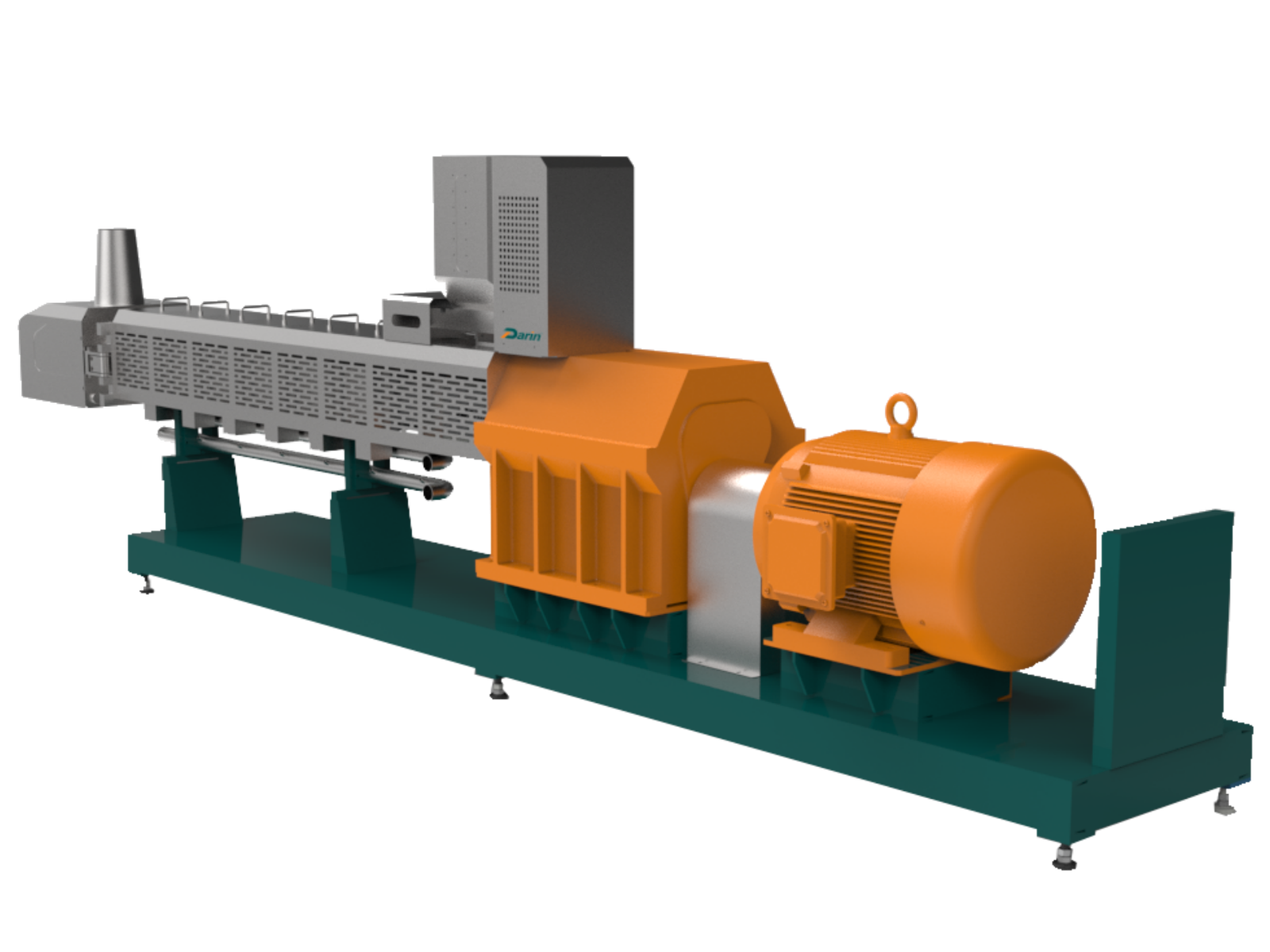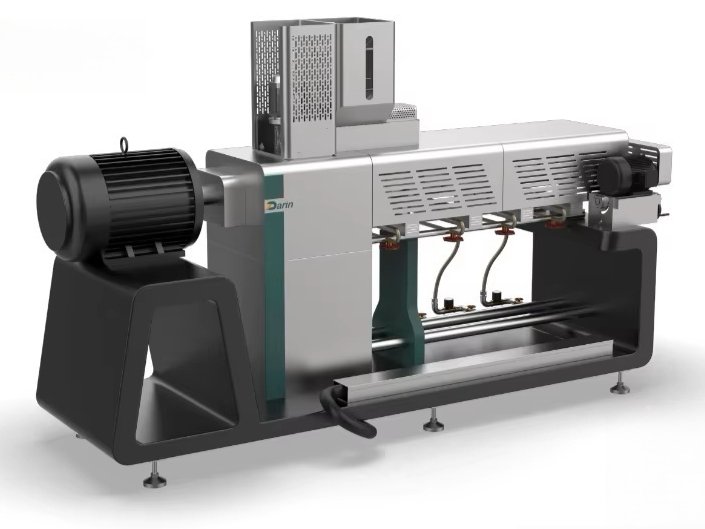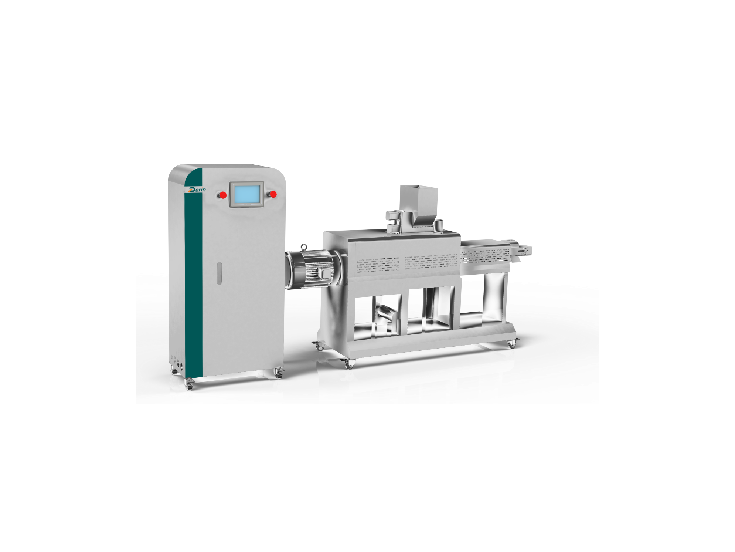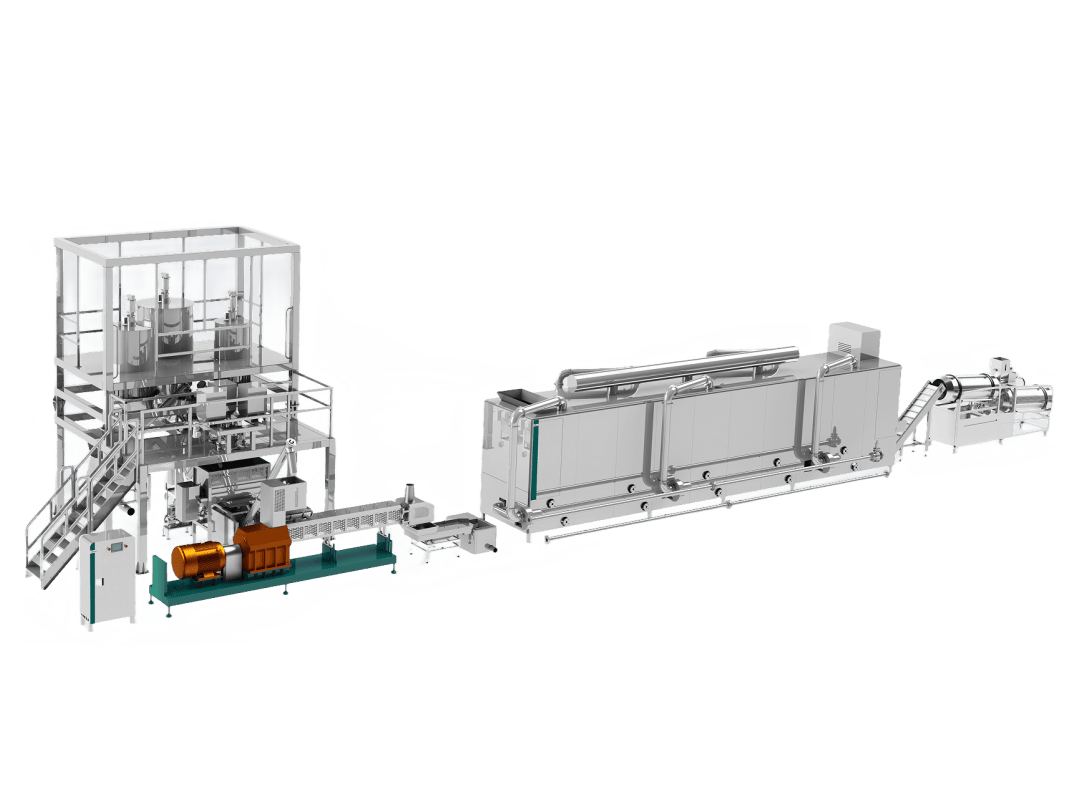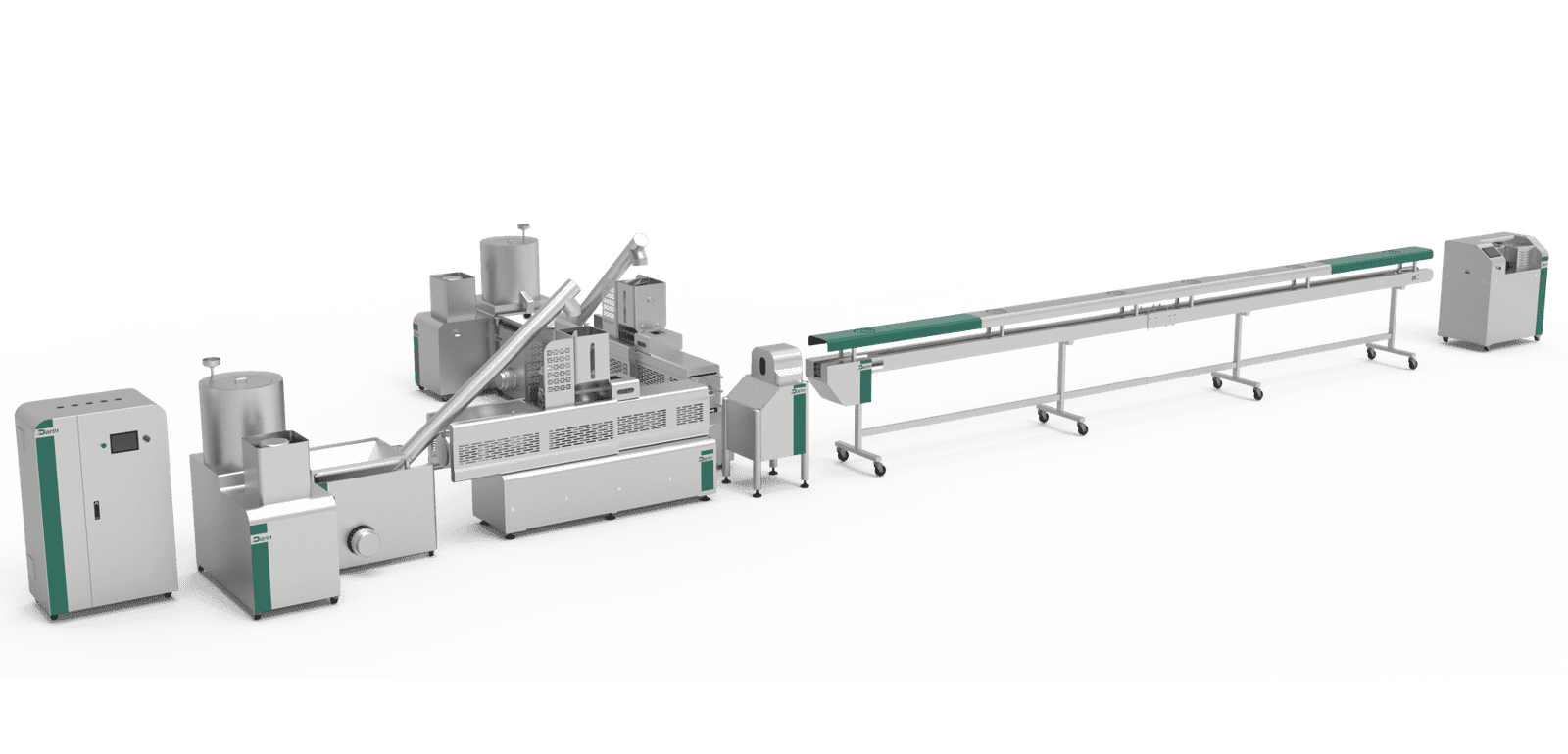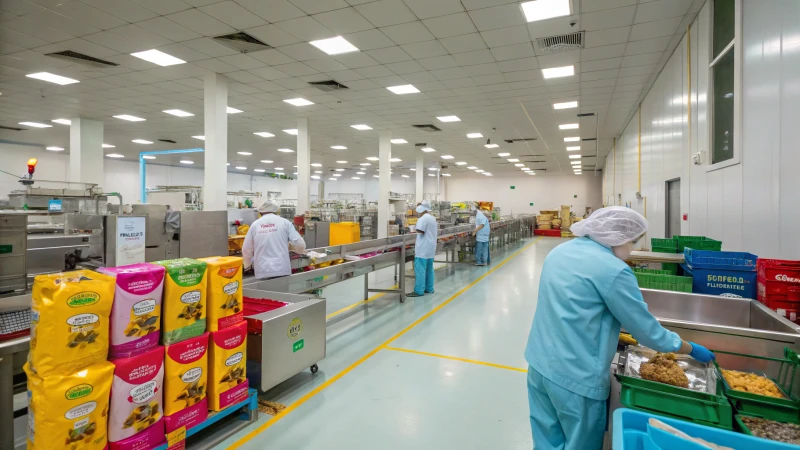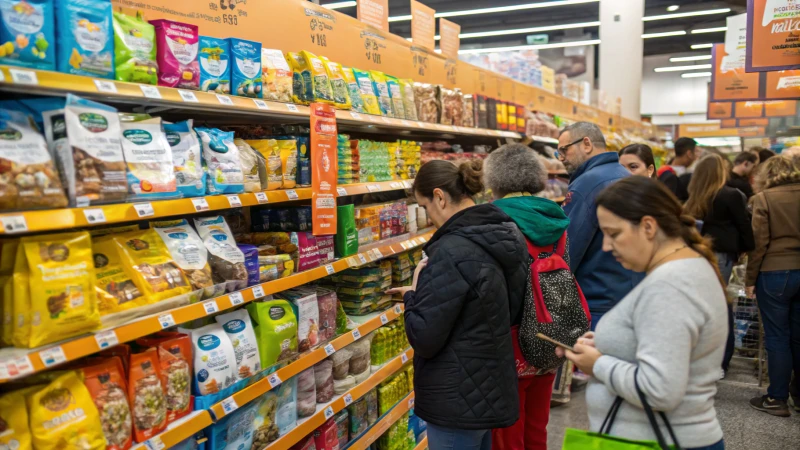
The global pet food industry is thriving — yet entering it successfully remains a challenge for many entrepreneurs. Most start-ups underestimate how complex dog food manufacturing really is: it’s not just mixing ingredients but engineering a safe, nutritious, and profitable product that meets global regulations. Without the right formulation, production line, or business model, even passionate founders quickly face financial and operational hurdles.
However, with a structured plan — backed by industrial-grade technology and regulatory guidance — it’s entirely possible to build your own dog food brand from scratch. This detailed, 12-step guide reveals exactly how to do it — from concept and recipe design to full-scale factory operation — based on proven experience from Darin Machinery, a professional pet food production line manufacturer trusted worldwide.
To start your own dog food business, you must define your niche, create balanced formulations, comply with legal standards, set up a professional extrusion or baking line, manage quality control, and build your brand and distribution network. Following this structured process helps you transform from a pet lover into a professional pet food manufacturer serving both domestic and global markets.
Many entrepreneurs enter the pet food industry out of love for animals — but real success depends on professional execution. Keep reading as we walk step by step through the complete technical and commercial roadmap of launching your own dog food brand.
Starting a dog food business only requires a kitchen and some ingredients.False
While you can experiment with recipes at home, commercial dog food production requires industrial equipment, safety certifications, and compliance with feed regulations.
Step 1: Conduct Market Research and Define Your Niche
Before investing in machinery or ingredients, research your target audience and product category. The global dog food market exceeded USD 110 billion in 2024, with strong growth driven by premiumization and functional nutrition.
| Market Type | Description | Moisture | Shelf Life | Equipment | Target Segment |
|---|---|---|---|---|---|
| Dry Kibble | Most common, economical, long shelf life | 8–10% | 12–18 months | Extrusion line | Mass market |
| Wet Food | High flavor & moisture, canned or pouched | 70–80% | 1–2 years | Retort line | Premium, elderly dogs |
| Semi-moist Food | Soft, chewy texture | 20–30% | 6–9 months | Steam cooker | Training snacks |
| Freeze-dried Food | Lightweight, nutrient-rich | <5% | 12–24 months | Freeze dryer | High-end niche |
| Fresh/Refrigerated Food | Minimal processing, natural look | 60–70% | 1–2 weeks | Steam or sous-vide cooker | Urban market |
Identify what gap you can fill — maybe organic formulas, breed-specific nutrition, or functional foods for joints, digestion, or weight control.
Competitor research should include:
- Price comparison of 10–20 brands in your category
- Ingredient analysis and claims (grain-free, holistic, etc.)
- Retail channel mix (online/offline)
- Customer reviews to identify complaints or opportunities
After defining your niche, estimate your market entry scale — small-batch artisanal (≤200 kg/day), medium enterprise (500–2000 kg/day), or industrial (5+ tons/day). This affects your factory investment and choice of equipment.
Step 2: Develop Formulations and Nutrition Profiles
A successful dog food business starts with scientific formulation. Every formula must meet basic nutrient requirements for dogs at different life stages as outlined by AAFCO or FEDIAF.
Example — Nutritional Requirements (Dry Matter Basis)
| Nutrient | Adult Dog (%) | Puppy (%) | Senior Dog (%) | Function |
|---|---|---|---|---|
| Crude Protein | 18–26 | 22–32 | 16–24 | Muscle & tissue development |
| Crude Fat | 8–15 | 10–20 | 8–12 | Energy & skin health |
| Fiber | 2–5 | 2–4 | 3–6 | Digestive regulation |
| Ash | 5–8 | 6–9 | 5–7 | Mineral balance |
| Moisture | ≤10 | ≤10 | ≤10 | Shelf stability |
Sample Chicken & Rice Kibble Formula (100 kg batch)
- Chicken meal: 30 kg
- Corn flour: 20 kg
- Rice flour: 15 kg
- Chicken fat: 10 kg
- Soybean meal: 10 kg
- Vitamin & mineral premix: 2 kg
- Palatant/flavor: 0.5 kg
- Water: 12.5 kg
Tip: Adjust formulas based on raw material cost, local availability, and digestibility. For high-end products, include ingredients like salmon oil, kelp, or probiotics.
Dog food formulations can ignore life-stage differences.False
Puppies, adults, and seniors require different nutrient ratios; incorrect formulation can cause health issues and regulatory noncompliance.
Step 3: Secure Licenses, Permits, and Certifications
Legal compliance is essential before producing or selling dog food. You’ll need business registration, feed production licenses, and product approval.
| Region | Regulatory Body | Key Certifications | Notes |
|---|---|---|---|
| USA | FDA, AAFCO, USDA | FDA registration, labeling review | Must follow AAFCO nutrient profiles |
| EU | FEDIAF, EFSA | CE, ISO22000, HACCP | Ingredient traceability required |
| China | MARA | Feed Production License | Follows GB/T 31216–2014 |
| Global Export | SGS, BV | ISO, HACCP | Mandatory for international trade |
Also ensure compliance with labeling laws, which require guaranteed analysis, feeding guidelines, and lot traceability.
Step 4: Choose the Right Equipment and Production Line
Your machinery determines product quality, efficiency, and cost per kg. For most start-ups, an extrusion line is the best balance between flexibility and scalability.
Typical Dry Dog Food Line by Darin Machinery
| Process | Machine | Description |
|---|---|---|
| Mixing | Ribbon Mixer | Uniformly blends dry ingredients |
| Extrusion | Twin-Screw Extruder | Cooks and shapes kibble under heat & pressure |
| Drying | Multi-layer Dryer | Reduces moisture to 8–10% |
| Coating | Flavor & Oil Coater | Enhances taste and nutrition |
| Cooling | Cooling Conveyor | Stabilizes product temperature |
| Packaging | Automatic Weigher & Sealer | Ensures consistent bag weights |
Capacity Options
| Model | Capacity (kg/h) | Power (kW) | Estimated Cost (USD) |
|---|---|---|---|
| DR-65 | 100–150 | 45 | 35,000–50,000 |
| DR-70 | 200–400 | 60 | 60,000–85,000 |
| DR-85 | 500–1000 | 90 | 90,000–150,000 |
| DR-95 | 1000–2000 | 130 | 160,000–250,000 |
All Darin extruders are made from food-grade SS304 stainless steel and feature PLC control, auto temperature systems, and modular die designs for flexible product shapes.
Step 5: Set Up Factory Layout and Infrastructure
A well-planned layout ensures smooth workflow and hygiene compliance. Follow GMP (Good Manufacturing Practice) and HACCP zoning principles.
Suggested Layout Zoning
- Raw Material Storage: clean, ventilated, low humidity
- Mixing & Extrusion Area: separate from packaging to prevent cross-contamination
- Drying & Cooling Area: dust-free, with controlled airflow
- Coating & Packaging: temperature-controlled
- QC Lab: testing for moisture, protein, and microbial load
- Finished Goods Warehouse: pest-proof, on pallets
Factory Investment Example (Small-Medium Scale)
| Item | Estimated Cost (USD) |
|---|---|
| Land & Construction (1000 m²) | 50,000–80,000 |
| Equipment Line | 70,000–120,000 |
| Utilities (electric, steam, water) | 10,000–20,000 |
| Packaging System | 10,000–25,000 |
| Licensing & Certification | 5,000–10,000 |
| Initial Raw Materials | 5,000–15,000 |
| Total (approx.) | 150,000–250,000 USD |
A medium-scale dog food factory can be established with $200K–$300K initial investment, depending on local costs.
Dog food factories can be built without zoning or food safety considerations.False
Food production facilities must follow sanitary zoning and airflow separation to prevent contamination.
Step 6: Implement Quality Control & Testing Protocols
Quality defines brand reputation. Establish a Quality Management System (QMS) aligned with HACCP, ISO22000, or GMP.
Key QC Parameters
| Test | Standard Range | Frequency | Method |
|---|---|---|---|
| Moisture | ≤10% | Each batch | Oven drying |
| Protein | 18–30% | Each batch | Kjeldahl/NIR |
| Fat | 8–20% | Each batch | Soxhlet extraction |
| Salmonella | Negative | Weekly | Microbiological |
| Mold & Yeast | <100 CFU/g | Weekly | Petri film |
| Shelf Life | ≥12 months | Quarterly | Oxidation & rancidity |
Conduct palatability tests with actual dogs — acceptance rates above 70% indicate success. Record data for continuous improvement.
A stable QC system reduces recalls, builds distributor confidence, and supports export certification.
Step 7: Branding, Packaging & Marketing Strategy
Once your production system is ready, it’s time to build brand visibility and emotional connection. Pet owners are increasingly loyal to brands that convey trust, transparency, and health.
Branding Principles for Dog Food Companies
- Authenticity: Clearly communicate your values — e.g., “human-grade ingredients,” “grain-free,” or “locally sourced meats.”
- Clarity: Simplify complex claims; avoid technical jargon unless targeting professionals (like veterinarians).
- Design: Use natural colors (earth tones, greens, blues), minimalistic fonts, and realistic pet imagery.
- Trust Symbols: Add certifications (HACCP, ISO22000, CE) and QR codes linking to traceability data.
- Emotional Hook: Connect with pet owners’ values — “care like family,” “nutrition with love.”
Packaging Design Guidelines
Use multi-layer laminated bags (PET/PE, OPP/AL) with resealable zippers for moisture protection. Label must include:
- Guaranteed Analysis (% of protein, fat, fiber, moisture)
- Ingredient list in descending order
- Feeding guide (per dog weight)
- Manufacturing date & lot number
- Storage conditions and shelf life
- Company contact info and origin
| Package Size | Typical Material | Cost (USD/unit) | Market Segment |
|---|---|---|---|
| 500 g | PET/PE matte finish | 0.12 | Small retail packs |
| 2 kg | PET/AL/PE | 0.25 | Medium urban users |
| 10–20 kg | OPP woven bag | 0.45 | Breeders, farms, bulk |
| 100 g pouches | Aluminum foil | 0.08 | Sample packs |
Marketing Channels
- Online Direct-to-Consumer (D2C): Website + Shopify + social media ads.
- Retail Distribution: Partner with pet stores, groomers, and veterinary clinics.
- Export Sales: List on Alibaba, Global Sources, or PetFair Asia events.
- Influencer Marketing: Collaborate with pet bloggers or trainers.
- Trade Exhibitions: Attend Interzoo, Global Pet Expo, and China Pet Fair.
Example: A Darin Machinery client in Poland launched a local grain-free brand in 2024 and achieved 30% monthly growth after optimizing packaging with eco-friendly kraft materials.
Dog food packaging doesn’t affect customer choice.False
Studies show over 60% of pet owners choose dog food based on packaging design and information clarity.
Step 8: Distribution Network & Sales Channels
A solid distribution strategy ensures profitability. Many startups fail because they underestimate logistics and shelf access.
Distribution Models
| Model | Description | Advantages | Challenges |
|---|---|---|---|
| Direct Sales (D2C) | Sell via website or social media | Higher margin, brand control | Needs digital marketing |
| Retail Distribution | Sell through pet shops, vets | Wider reach | Requires sales reps & stock |
| Wholesale (B2B) | Supply to distributors | Stable cash flow | Lower margins |
| Private Label Production | Manufacture for other brands | Fast scaling | Low branding visibility |
| Export Trade | Sell to other countries | Large volume | Certification & logistics complexity |
Logistics & Storage
- Store dog food at ≤25°C, ≤60% humidity.
- Use FIFO (First In, First Out) inventory systems.
- Consider palletized packaging for container export.
Distribution Tips
- Offer smaller packaging (≤5 kg) for eCommerce.
- Provide QR codes for online reviews.
- Use ERP software to track sales and production lots.
- Offer loyalty programs or subscription boxes.
Step 9: Financial Planning and ROI Analysis
A sustainable dog food business depends on precise cost management.
Example: 1 Ton/Day Dry Dog Food Factory (DR-70 Line)
| Category | Description | Estimated Cost (USD) |
|---|---|---|
| Raw Materials (meat, grain, additives) | Average 0.8 USD/kg | 800/day |
| Utilities (electricity, water, steam) | 0.1 USD/kg | 100/day |
| Labor (4–6 workers) | Daily wage + overhead | 150/day |
| Packaging | Bags & labels | 80/day |
| Maintenance & Misc | Wear parts, cleaning | 50/day |
| Total Production Cost | 1.15 USD/kg | 1,150/day |
| Average Selling Price | 1.8 USD/kg | 1,800/day |
| Daily Profit | 0.65 USD/kg | 650/day |
| ROI Period | 8–12 months | — |
Profit Maximization Tips
- Source ingredients locally to reduce freight.
- Optimize extrusion temperature to save energy.
- Offer OEM/ODM production for other brands.
- Automate packaging to cut labor costs.
Step 10: Sustainability and Innovation
Modern consumers value sustainability. Consider integrating:
- Recycled Packaging: Reduce carbon footprint.
- Plant-Based Proteins: Use pea, lentil, or insect protein for eco-friendliness.
- Energy Recovery Systems: Reuse exhaust heat from dryers.
- Waste Utilization: Convert off-spec kibble into animal feed pellets.
Innovation opportunities include:
- Functional foods (joint care, skin health).
- Breed-specific formulations.
- Personalized nutrition (AI-driven dog diet plans).
- Freeze-dried and air-dried treats.
Pet owners rarely care about sustainability in dog food.False
Sustainability has become a major purchase driver; over 70% of Gen Z owners prefer eco-conscious brands.
Step 11: Factory Management, Staffing & Safety
Operating efficiency determines long-term success.
Key Roles in a Dog Food Factory
| Role | Responsibility | Recommended Headcount |
|---|---|---|
| Production Manager | Oversee daily operations | 1 |
| Formulation Specialist | Manage recipes & QA | 1 |
| Machine Operator | Extruder & dryer control | 2 |
| Packaging Supervisor | Packaging & labeling | 2 |
| QC Analyst | Sampling & lab testing | 1 |
| Maintenance Technician | Preventive maintenance | 1 |
Train all staff in food hygiene, safety protocols, and hazard control.
Implement PPE, CCTV monitoring, and traceability documentation for every batch.
Safety checklist includes:
- Regular machine inspection
- Emergency stop systems on extruders
- Dust control and fire prevention in dryers
- Safe storage of raw fats and vitamins
Step 12: Case Study — Darin Machinery Client Success
Case Overview:
A South American start-up approached Darin Machinery in 2023 to set up a 1.5-ton/hour dry dog food plant focusing on chicken-based premium kibble.
Implementation Process:
- Design & Layout: Darin engineers created a 3D plant layout for a 1200 m² site.
- Equipment Supply: DR-85 twin-screw extruder with automatic weighing and PLC control.
- Training: On-site installation and operator training by Darin technicians.
- Formulation: Collaborative development with a veterinary nutritionist for high-protein recipes.
- Certification: Assistance with ISO22000 and CE audit documentation.
Results After 6 Months:
| Metric | Before Launch | After Launch |
|---|---|---|
| Daily Output | 0 | 1.5 tons |
| Local Market Share | 0% | 7% |
| Product Range | 0 | 3 SKUs |
| ROI | — | 10 months |
| Customer Satisfaction | — | 95% positive |
They now export to Chile, Peru, and Colombia — proving how proper machinery and process design transform ideas into thriving businesses.
Conclusion
Building a dog food business from scratch is a journey that merges science, technology, and passion. It’s not just about feeding pets — it’s about producing reliable nutrition backed by industrial consistency and trust. With the right partners, machinery, and dedication, you can scale from a local producer to a global brand.
From market research and formulation to packaging and export, every detail matters. Invest in quality equipment, compliance, and continuous innovation — and your brand will stand among the global leaders of the pet food industry.
Build Your Dog Food Business with Darin Machinery
If you’re serious about starting your own dog food production line — Darin Machinery is ready to support you from A–Z:
- Complete turnkey extrusion lines (100–5000 kg/h)
- Custom layout design and training
- Recipe formulation & quality testing assistance
- OEM/ODM and international compliance support
📞 WhatsApp: +86 156 5000 7983
🌐 Website: www.petreatsmachine.com
📧 Email: darin4@darin.cn
Let’s build your dream pet food brand — with reliable technology, science-backed nutrition, and Darin Machinery’s expertise.



